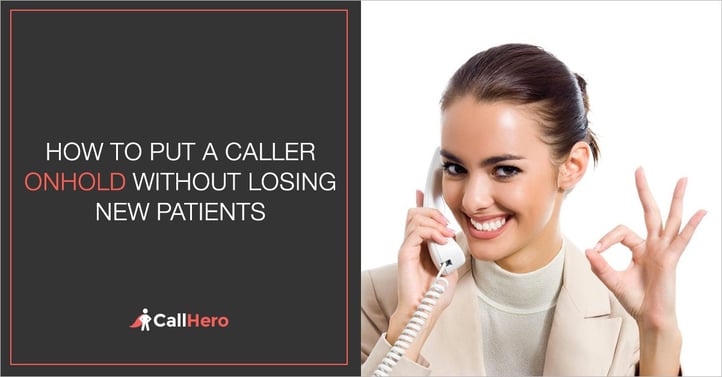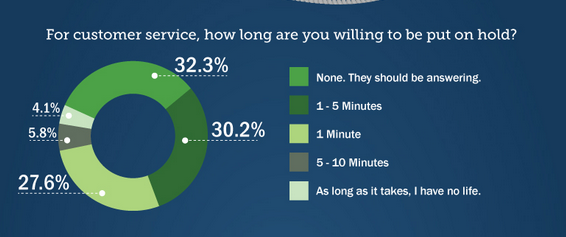
Let me start by asking you a question: Do you like being put on hold?
Likely the answer is no. Because let’s face it, none of us do!
So… have you stopped to question HOW your clinic is putting patients on hold?
Chances are you haven’t.
That means you’re probably making the mistake most other clinic’s make.
When a caller rings, you (or your front desk) put a caller on hold by saying:
“Hello, this is ABC Clinic, please hold.”
So what’s wrong with this, you ask?
The answer is: everything is wrong with it!
There’s no consideration for the person on the other end, you haven’t used the most basic of customer service principles, and you’ve forgotten one major priority: the new patient caller.
If you are currently using the above script to place patients on hold, as a consequence, a large percentage of those callers will hang up and ring your competitor, especially new patients.
For real! At CallHero, we analyze a lot of phone calls and our phone call analytics shows that, if put on hold, more than 50% of callers will hang up within the first 3 minutes.
More than 50% - that’s a lot of callers!
The good news is there is an effective way to put callers on hold so you don’t lose them.
Let’s dig into that now and I’ll also give you the exact script I use with the clinic's I mentor.
Start by recognizing your priorities
Sure, you (or your front desk) are busy. There’s a million things going on and you have no choice but to put people on hold. I get that. Sometimes it will be necessary.
BUT, don’t lose sight of your #1 priority: the new patient caller.
While an existing patient will likely wait on hold or call back. If not managed right, a new patient could be gone, never to return.
That’s a terrible loss of a lead that you’ve spent good marketing dollars to acquire!
The solution is you have to triage calls, just like they do in the emergency room.
When patients come into the emergency room, the nurse asks a few quick questions to determine the priority of each case. And that’s exactly what you need to do to determine if it’s a new patient on the line.
For instance, you could say: “May I ask, are you an existing patient?”
If they answer yes, you can proceed by putting them on hold.
But if it is a new patient, you need to put them at the front of the line and put everything else on hold or risk losing that patient to your competitor.
The average new patient takes about 4 minutes (accordingly to our phone call analytics) to book so, prioritize their booking.
If you have a patient waiting to pay, ask them to wait.
If you’ve got an existing patient on the other line, ask if you can call them back within 10 minutes.
Get your Ultimate Phone Training Guide
The Phone Lady Reveals 23 Killer Secrets. CLICK HERE to download
Best on hold practices
The sooner you realize that the money is in the phones (& front desk training), the sooner you will see a dramatic growth in your health business.
Of course, it is always going to be necessary to put callers on hold at some point. And that’s fine, as long as you do it right.
Here are a few guiding principles to follow:
Get permission
Always ask the person’s permission before placing them on hold.
That means, don’t answer the phone with: “Hello, this is ABC Clinic, please hold.”
It’s just not a great way to begin the relationship, or nurture relationships you may already have with existing patients.
Every chance you get to make a good impression, makes a difference!
You must always ask the caller for permission to be put on hold.
For example, “Would you mind holding for one minute?”
Beat Your Competitors With Every CallDiscover your front desk’s strengths and areas for improvement with our Mystery Caller Audit
|
Give a reason
Provide a brief explanation why you need to put the caller on hold.
To help comfort the caller, it’s important to provide justification for putting them on hold.
It doesn’t have to be anything elaborate, just a simple explanation will do.
For instance, “I apologize. Would you mind holding for one minute? I’m just finishing up with a patient and will be right with you.”
Give them options
Make it easy for the caller and give them the option to stay on hold or a call back.
If the caller doesn’t want to stay on hold, ask for their number and suggest a call back time.
For example, “If you prefer I can call you back within the 10 minutes.”
Don’t keep the caller waiting too long
As you can see by the image bescrlow, 32.3% of people will not wait and be put on hold. While another 27.6% say they will wait for 1, it doesn't mean they are always happy to do so, which is why it's best to minimize on-hold time so you don't lose the call.

Featured Photo: How long are you willing to wait? via Konnect
It’s preferable to only keep callers waiting for 1 minute before getting back to them again, even if that means asking them to wait a little longer.
Don’t leave the caller in silence
Most callers placed on “silent hold” estimate their on-hold time to be more than double the actual time.
The solution is to record professional messages with background music and info about your clinic to keep the patient entertained, engaged, and comforted.
By using the above best practices, you’ll find your patients will be happier on hold, which means you won’t lose as many callers.
The Ultimate On-hold Call Script
Here’s the script I use with the clinic's I mentor:
[STAFF] “Good Morning, this is ABC Clinic, Becky speaking. How can I help you?”
[CALLER] “Hi, I'm calling to find out how much it costs for a visit.”
[STAFF] “Sorry I didn’t catch your name?”
[CALLER] “Sara.”
[STAFF] “Hi Sara, I apologize but I’m just finishing up a with a patient. Are you comfortable with holding for one minute or if you prefer I can call you right back in 10 minutes?"
Putting patients on hold in an effective way is not difficult to do, but you do have to do it.
When every new patient call is worth thousands, you can’t afford to lose those callers, especially new patients who probably won’t ring your clinic again.
Use the above information to train your whole team and put callers on hold effectively. The sooner you realize that the money is in the phones (& front desk training), the sooner you will see a dramatic growth in your health business.
Any business that fields a large enough volume of calls that causes some to get missed can improve conversion rates using call recording.
If you lost new patients, watch this video to get the script to win them back!




